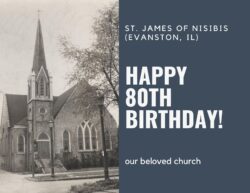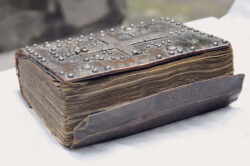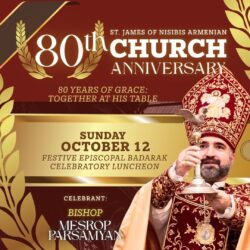ATTENDANCE
The Divine Liturgy or the Holy Mass (Soorp Badarak), which is the main service in our church on Sunday, starts, as a rule, at 10.00 a.m. However, if for one reason or another you have been delayed, it is better to arrive a little late than not to attend at all. When you are attending the church service, let your apparel be appropriate and modest. Abstain from adornments and flashy clothing which are not suitable in the church atmosphere, where a spirit of concentration and meditation is required as a precondition to participate in a communal prayer. Please, be aware that Church canons dictate that women should cover their heads in church.
ENTERING
Your entrance into the church must be reverent and gentle. Make sure that all of your electronic devices are on silent mode. As you enter the church, it is appropriate to cross yourself. It is also an age long Armenian tradition, just as it is customary in Eastern Orthodox and Catholic churches too, to light a candle as a way of placing yourself in a contemplative mood. The lighting of the candle is also a symbol of the sacrifice of the self and the radiance of Christian’s love. Just as the candle burns and is consumed to spread light, so must every Christian man and women live to radiate love, light and warmth. It is a genuine Armenian custom of piety to light the candle in front of an anointed picture of a Saint, to pose for moment and breathe a prayer of self-dedication and to prepare oneself spiritually to participate in the church service.
Then you may take a copy of the Sunday Bulletin and proceed to the pews. Early comers should take the front pews and leave the back ones for those who come later. When you take your place, bow your head slightly, make the sign of the cross, and inaudibly say “The Lord’s Prayer.” You are now ready to participate in the service.
Please be advised that according to the tradition of the Armenian Church, members of the congregation are strongly reminded to refrain from walking in and out of the Sanctuary while services are in progress, especially during:
- The Chanting of the Gospel
- Recitation of the Creed (Havadamk)
- The Chalice Procession (Veraberoum)
- Singing of Lord’s Prayer (Hayr Mer)
- The Hymn, “Der Voghormia”
- Confession
- Processionals
PARTICIPATION
All movements in the church, such as sitting, rising, kneeling, bowing and walking should be done quietly and gracefully, with a thoughtful attitude. To talk, to attract others’ attention, to disturb the concentration of fellow worshipers with unnecessary motions are not permitted. When in the church, we should feel and make others feel that we are not in a common meeting hall, but in an environment which is sanctified by the presence of God. The church is a house of prayer, a place of dwelling for God and a place of penitence for men; in a word, it is a place of spiritual purification. Our Lord said: “My house shall be called a house of prayer.” (Matt. 21:33.)
The congregation must participate softly in the singing of those parts of the Divine Liturgy sung by the choir. They should join in particularly when some of the more frequent hymns (sharagans) are sung, without, however, disturbing the musical harmony which, by itself, induces and elevation atmosphere in the ritual of our church. That solemn atmosphere inductive to prayer, spiritual renewal and introspection should be maintained at all times. The solo parts of the Divine Liturgy should be listened to in perfect silence, using those moments for meditation and self-searching.
BOWING
Bowing, as a sign of reverence and adoration, is most frequently practiced in the Armenian Church. It is almost invariably performed with the making of the sign of the cross and kneeling.
During the Divine Liturgy the direction to bow is always given by the Deacon with the words “Asdoodzo yergir-bakestzook” (Let us bow down to God). On other occasions, it is given by the priest while reading the prayers with the same words. At these biddings everyone in the church, the priest, the servers, the choir and the congregation alike, should bow the head, as well as the body at the waist.
Always bow and cross yourself while walking past the Altar.
While passing in front of the member of the clergy present in the chancel, you make a slight inclination of the head without, however, making the sign of the cross.
MAKING THE SIGN OF THE CROSS
Making the sign of the cross is repeated often in the Armenian Church, as it is in all the Eastern Churches. The holy sign of the cross, as a reminder of the life-giving suffering and sacrifice of the Lord, has been from the earliest times a sacred object of veneration. A special power is attributed to the use of this holy sign. It is the sacred symbol of Christ and the holy emblem of the Christian religion as a whole. Crossing oneself with three fingers signifies blessing oneself in the name of the Holy Trinity. It means also professing one’s faith as a follower of the One Who was crucified. It is at the same time an expression of readiness to bear one’s own cross as a good soldier of Christ.
The sign of the Cross is made when entering the church and on these occasions during the Divine Liturgy:
- After each instance of bowing.
- When doxology (Park Hor), that is to say, “Glory to the Father and to the Son and to the Holy Spirit” is being said or sung.
- When the sacred name of our Lord is being solemnly invoked.
- At the beginning of the reading of the Gospel.
- When peace or blessing is being given by the priest with the words: “Peace unto all” (Khaghaghootune Amenetsoon).
- When a deacon or the priest swings the censer towards your direction.
- When the most sacred and the central words of the Divine Liturgy are being spoken: “Take, eat, this is my body …” and “Drink ye all, this is my blood …”
- When kissing the Gospel and leaving the church.
HOW TO MAKE THE SIGN OF THE CROSS
Join the thumb, index and middle fingers of the right hand at the tips.
Bend the ring and little fingers into the palm at ease.
Touch the forehead with the tips of three joined fingers saying: “In the name of the Father …”
Next touch the middle of the chest, saying: “and of the Son …”
Then touch first the left and then the right sides near the shoulders saying: “and of the Holy Spirit …”
Finally, open your hand and put it on your heart, saying: “Amen.”
LEAVING
Your departure from the church should be as reverent and as orderly as your entrance. When the church service is over and the officiating priest pronounces the benediction of dismissal in these words: “Blessed be ye through the grace of the Holy Spirit and depart in peace, and may the Lord Jesus be with you all, Amen.” The congregation should not rush out from their seats in disorder causing congestion. Each person should remain in place a moment longer with concentrated thoughts, should cross himself or herself once again and after whispering a prayer of re-dedication should proceed out quietly, expressing the internal peace and happiness.
When the service is over, the officiating clergy holds the Gospel Book or a cross. The faithful approach him one by one in single line, kiss the Gospel as they pass, receive the blessing of the priest and leave the church. It is not proper to stop and talk to the priest while kissing the Gospel Book. If you have something to say to your priest, stand aside and wait until everybody has kissed the Gospel Book and then talk to your clergyman.
TAKING “MAHS” (Holy Bread)
At the end of the Divine Liturgy the “Mahs” or holy bread is distributed among the congregation. “Mahs” is an Armenian word, not related at all to the English word (Holy) “Mass.” “Mahs” means “share” or “portion.” When you take your “Mahs” you kiss it and eat it. It is good practice to take some home to those members of the family who were unable to attend. Taking “Mahs” does not mean Communion. It is survival of the fellowship meal called “Agape” in Greek which early Christians used to have as a part of the Holy Eucharist. It is only a sign of Christian charity and spiritual kinship.













